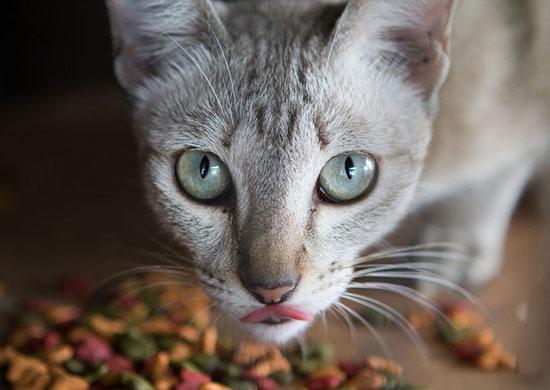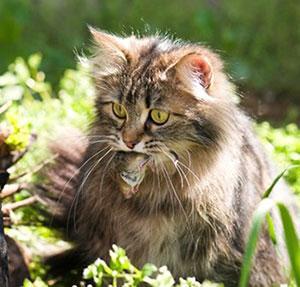This content is archived from the Feline Nutrition Foundation
Answers: The Paradox of Prescription Diets for Cats
- Updated: Wednesday, May 15, 2019 12:27 PM
- Published: Saturday, April 02, 2016 03:49 PM
- Written by Guillermo Díaz. MV
 My cat is two years old. I adopted him as a kitten when he was just three months old. Since then, he's been eating only a veterinarian-recommended diet. When he reached his first year of life, he began having urinary issues that finally led him to a blockage. After a long, painful and costly recovery, my vet recommended a prescription diet only, for the rest of his life. He was doing fine and seemed to enjoy his new dry food. Four months later he relapsed and I had to take him to the emergency vet. Why did this happen? Isn't the prescription diet supposed to prevent this? Did I do something wrong? I only followed the doctor's advice. I'm afraid this is going to happen again.
My cat is two years old. I adopted him as a kitten when he was just three months old. Since then, he's been eating only a veterinarian-recommended diet. When he reached his first year of life, he began having urinary issues that finally led him to a blockage. After a long, painful and costly recovery, my vet recommended a prescription diet only, for the rest of his life. He was doing fine and seemed to enjoy his new dry food. Four months later he relapsed and I had to take him to the emergency vet. Why did this happen? Isn't the prescription diet supposed to prevent this? Did I do something wrong? I only followed the doctor's advice. I'm afraid this is going to happen again.
Because cats evolved in desert climates, their physiology has a specialized metabolism that conserves water. Cats have a very low thirst drive when compared to other species. This is why it's critical for them to ingest a water-rich diet, where the majority of their water intake is actually in the food itself. When cats feed naturally on raw animal tissues, their urinary system stays healthy because there is an appropriate amount of water flowing through the entire urinary tract. This fluid intake forces all of the byproducts of normal metabolism present in the bladder to be expelled several times a day. Raw cat food has a high water content of around 75 percent.¹ Compare this to the water content in dry, plant-based foods of 10 percent or less.
High dietary water intake is related to a significant increase in urine volume, reduction in the urine's specific gravity and a decrease in urinary crystals, demonstrating the beneficial effects of high-moisture diets on cat urinary parameters.² A study conducted by Dr. AE Stevenson has demonstrated that a diet high in moisture boosts a cat's total daily water intake to a level that cannot be achieved by simply providing drinking water alongside dry food.³ The higher daily water intake resulted in increased urine volume and dilution.
 The second important issue to consider is the quality of the urine, and that means pH. The pH of urine is a measure of how acidic or alkaline it is. A pH of 7 is neutral. Everything above 7 is alkaline, everything below is acidic. The urine pH can be greatly influenced by diet. Normal urine in the cat and dog is mildly acidic and ranges from 6 to 6.5. Extremes in urine pH are more likely to be associated with disease. For example, a cat with highly-alkaline urine is more susceptible to bladder infections and may develop urolithiasis.⁴ An alkaline urine insults the integrity of the mucous layer of the urinary bladder which leads to inflammation and bacteria proliferation. One of the most common crystals found in the urine of blocked cats is struvite. It has been shown that the potential for struvite crystal formation is reduced if urine pH is 6.6 or below.⁵
The second important issue to consider is the quality of the urine, and that means pH. The pH of urine is a measure of how acidic or alkaline it is. A pH of 7 is neutral. Everything above 7 is alkaline, everything below is acidic. The urine pH can be greatly influenced by diet. Normal urine in the cat and dog is mildly acidic and ranges from 6 to 6.5. Extremes in urine pH are more likely to be associated with disease. For example, a cat with highly-alkaline urine is more susceptible to bladder infections and may develop urolithiasis.⁴ An alkaline urine insults the integrity of the mucous layer of the urinary bladder which leads to inflammation and bacteria proliferation. One of the most common crystals found in the urine of blocked cats is struvite. It has been shown that the potential for struvite crystal formation is reduced if urine pH is 6.6 or below.⁵
It is well known that herbivores, such as rabbits and horses, have a more alkaline urine because they eat primarily grains and grasses. When cats are fed a dry, grain-based diet, as is the case with almost all commercial dry cat foods, their urine becomes alkaline. This predisposes them for the formation of struvite stones and inflammation of the urinary bladder. This inflammation is called cystitis. Dry foods have been implicated as a risk factor for cats susceptible to feline lower urinary tract disease. Feeding wet foods has been shown to reduce the recurrence of calculi and signs of idiopathic cystitis compared with dry.⁶ ⁷
Additional Reading
A Diet for Your Cat's Urinary and Kidney Health
Pet food manufacturers are well aware that dry, grain-based foods promote alkaline urine. In order to "fix" their foods that are primarily corn, wheat and soy, they artificially acidify it by adding products such as DL Methionin and potassium citrate. It is a sad paradox to label any water-depleted dry food as a "urinary tract diet." It makes no sense to put our blocked cats on this kind of food when Mother Nature provides a diet that promotes excellent urinary health. It's a natural, prey-based diet our obligate carnivores evolved to eat over thousands of years. We replicate it today with raw cat food.
Note: Feline Nutrition provides feline health and nutrition information as a public service. Diagnosis and treatment of specific conditions should always be in consultation with your own veterinarian. Feline Nutrition disclaims all warranties and liability related to the veterinary advice and information provided on this site.
Dr. Guillermo Díaz and family, including their four dogs (Leroy, Xica, Moza and Pepa) and six cats (Michalina, Tigger, Vladimir, Yellow, Mongo and Chirusa) moved to Buenos Aires, Argentina in July of 2017, where he expects to continue supporting different animal rescue groups, spread the benefits of raw food for cats and dogs and write articles about nutrition.
1. "Chapter 3: Meat, Fat and Other Edible Carcass Parts," Meat Processing Technology For Small to Medium Scale Producers, Food & Agriculture Organization of the United Nations, FAO Document Repository.
2. CMF Buckley, A Hawthorn, A Colyera1 and AE Stevenson, "Effect of Dietary Water Intake on Urinary Output, Specific Gravity and Relative Supersaturation for Calcium Oxalate and Struvite in the Cat," British Journal of Nutrition 106, Supp S1, Oct 2011, S128-S130.
3. Buckley, et. al., "Effect of Dietary Water Intake on Urinary Output, Specific Gravity and Relative Supersaturation for Calcium Oxalate and Struvite in the Cat."
4. MD Finke and BA Litzenberger, "Effect of Food Intake on Urine pH in Cats," Journal of Small Animal Practice 33, No. 6, June 1992, 261-265.
5. Finke, et. al., "Effect of Food Intake on Urine pH in Cats."
6. CA Buffington, DJ Chew, MS Kendall, PV Scrivani, SB Thompson, JL Blaisdell and BE Woodworth, "Clinical Evaluation of Cats with Nonobstructive Urinary Tract Diseases," Journal of the American Veterinary Medical Association 210, No. 1, Jan 1997, 46-50.
7. PJ Markwell, CAT Buffington DJ Chew, MS Kendall, JG Harte and SP DiBartola, "Clinical Evaluation of Commercially Available Urinary Acidification Diets in the Management of Idiopathic Cystitis in Cats," Journal of the American Veterinary Medical Association 214, No. 3, Feb 1999, 361-365.




